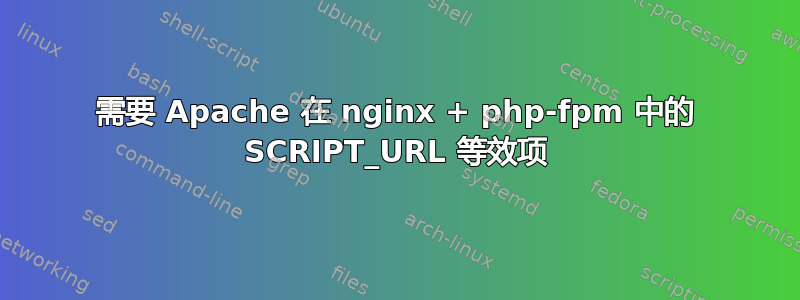
我正在将旧版 Zend Framework 应用程序移至 Nginx + php-fpm。以下是我的相关配置:
server {
listen 80;
server_name *.sandbox.journalexperts.com;
port_in_redirect off;
server_tokens off;
autoindex off;
include /etc/nginx/conf.d/assets.conf; # this file contains some info about not access logging robots.txt, favicon.ico, etc.
client_max_body_size 15m;
client_body_buffer_size 128k;
root /wwwroot/vhosts/$host;
index index.html index.php;
access_log off;
# deliver a static 404
error_page 404 /404.html;
location /404.html {
internal;
root html;
allow all;
}
# Deliver 404 instead of 403 "Forbidden"
error_page 403 = 404;
# Deny access to hidden files
location ~ /\. {
deny all;
access_log off;
log_not_found off;
}
location / {
try_files $uri $uri/ /index.php$is_args$args;
}
location ~ \.php$ {
include /etc/nginx/conf/fastcgi.conf;
fastcgi_intercept_errors on;
fastcgi_ignore_client_abort off;
fastcgi_connect_timeout 60;
fastcgi_send_timeout 180;
fastcgi_read_timeout 180;
fastcgi_buffer_size 128k;
fastcgi_buffers 4 256k;
fastcgi_busy_buffers_size 256k;
fastcgi_temp_file_write_size 256k;
fastcgi_pass 127.0.0.1:9000;
fastcgi_index index.php;
}
}
这是我的 fastcgi.conf 文件:
fastcgi_param CONTENT_LENGTH $content_length;
fastcgi_param REQUEST_URI $request_uri;
fastcgi_param DOCUMENT_ROOT $document_root;
fastcgi_param SERVER_PROTOCOL $server_protocol;
fastcgi_param GATEWAY_INTERFACE CGI/1.1;
fastcgi_param SERVER_SOFTWARE nginx/$nginx_version;
fastcgi_param REMOTE_ADDR $remote_addr;
fastcgi_param REMOTE_PORT $remote_port;
fastcgi_param SERVER_ADDR $server_addr;
fastcgi_param SERVER_PORT $server_port;
fastcgi_param SERVER_NAME $host;
# PHP only, required if PHP was built with --enable-force-cgi-redirect
fastcgi_param REDIRECT_STATUS 200;
# http://wiki.nginx.org/HttpFastcgiModule#fastcgi_split_path_info
fastcgi_split_path_info ^((?U).+\.php)(/?.+)$;
fastcgi_param SCRIPT_FILENAME $document_root$fastcgi_script_name;
fastcgi_param PATH_INFO $fastcgi_path_info;
fastcgi_param PATH_TRANSLATED $document_root$fastcgi_path_info;
fastcgi_param SCRIPT_URL $script_url; # This is a mapped variable.
fastcgi_param SCRIPT_URI $scheme://$http_host$script_url; # Uses above mapped variable.
fastcgi_param QUERY_STRING $query_string;
fastcgi_param REQUEST_METHOD $request_method;
fastcgi_param CONTENT_TYPE $content_type;
fastcgi_param SCRIPT_NAME $fastcgi_script_name;
fastcgi_param PHP_SELF $uri;
fastcgi_param HTTPS $https if_not_empty;
我需要模仿 SCRIPT_URL 和 SCRIPT_URI 在 Apache 中的行为。我发现此主题海报用来map填充这些内容。
map $uri $script_url {
~^(?<script_filename>.+\.(php|html))(?<path_info>.+)$ $path_info;
~^(?<script_filename>.+\.(php|html))$ $script_filename;
}
不幸的是,这对我来说不起作用,并将 /index.php 显示为 SCRIPT_URI。我怀疑这是因为我的 try_files 块将请求发送到 /index.php。Nginx 文档支持这一点:
$uri
This variable is the current request URI, without any arguments (see $args for those). This variable will reflect any modifications done so far by internal redirects or the index module. Note this may be different from $request_uri, as $request_uri is what was originally sent by the browser before any such modifications. Does not include the protocol or host name. Example: /foo/bar.html
好的,让我们尝试使用重写地图$request_uri。
map $request_uri $script_url {
default $request_uri;
~^(?<script_filename>.+\.(php|html))(?<path_info>.+)$ $path_info;
~^(?<script_filename>.+\.(php|html))$ $script_filename;
}
这稍微好一点,但仍然没有达到预期的效果。这是我在 Apache 中得到的结果:
$_SERVER['SCRIPT_URL']: /tos/show.php/article/0000
$_SERVER['SCRIPT_URI']: http://example.com/tos/show.php/article/0000
这是我在 Nginx 中得到的结果:
$_SERVER['SCRIPT_URL']: /tos/show.php/article/0000?hello=world
$_SERVER['SCRIPT_URI']: http://example.com/tos/show.php/article/0000?hello=world
我不知道该怎么办。
答案1
这就是我最终做的事情,并且很有效。
nginx.conf,在 http{} 块中:
map $request_uri $my_script_url {
default $request_uri;
~^(?<script_filename>.+\.(php))(.*)?$ $script_filename; #/test.php or /test.php?hello=world
~^(?<script_filename>.*)(\?.*)$ $script_filename; #/tos?hello=world
~^(?<script_filename>.*)(\?.*)?$ $script_filename; #/tos or /tos/hello/world or /tos/hello/world?omg=what
}
我学到的东西:
- 正则表达式按自上而下进行匹配,当找到第一个匹配项时,处理停止。
- nginx 文档可以为我做很多事情。
在 server{} 块内:
location / {
try_files $uri $uri/ /index.php$is_args$args;
}
location ~* \.php(.*)?$ {
include /etc/nginx/conf/fastcgi.conf;
[...]
}
fastcgi.conf:
fastcgi_param CONTENT_LENGTH $content_length;
fastcgi_param REQUEST_URI $request_uri;
fastcgi_param DOCUMENT_ROOT $document_root;
fastcgi_param SERVER_PROTOCOL $server_protocol;
fastcgi_param GATEWAY_INTERFACE CGI/1.1;
fastcgi_param SERVER_SOFTWARE nginx/$nginx_version;
fastcgi_param REMOTE_ADDR $remote_addr;
fastcgi_param REMOTE_PORT $remote_port;
fastcgi_param SERVER_ADDR $server_addr;
fastcgi_param SERVER_PORT $server_port;
fastcgi_param SERVER_NAME $host;
# PHP only, required if PHP was built with --enable-force-cgi-redirect
fastcgi_param REDIRECT_STATUS 200;
# http://wiki.nginx.org/HttpFastcgiModule#fastcgi_split_path_info
fastcgi_split_path_info ^((?U).+\.php)(/?.+)$;
fastcgi_param SCRIPT_FILENAME $document_root$fastcgi_script_name;
fastcgi_param PATH_INFO $fastcgi_path_info;
fastcgi_param PATH_TRANSLATED $document_root$fastcgi_path_info;
fastcgi_param SCRIPT_URL $my_script_url;
fastcgi_param SCRIPT_URI $scheme://$http_host$my_script_url;
fastcgi_param QUERY_STRING $query_string;
fastcgi_param REQUEST_METHOD $request_method;
fastcgi_param CONTENT_TYPE $content_type;
fastcgi_param SCRIPT_NAME $fastcgi_script_name;
fastcgi_param PHP_SELF $uri;
fastcgi_param HTTPS $https if_not_empty;
try_files $uri =404;
php.ini文件:
; cgi.fix_pathinfo = 1
答案2
看起来您只需要去掉查询参数:
map $request_uri $script_url {
default $request_uri;
~^(?<script_filename>.+\.(php|html))(?<path_info>.+)(\?.*)?$ $path_info;
~^(?<script_filename>.+\.(php|html))(\?.*)?$ $script_filename;
}


